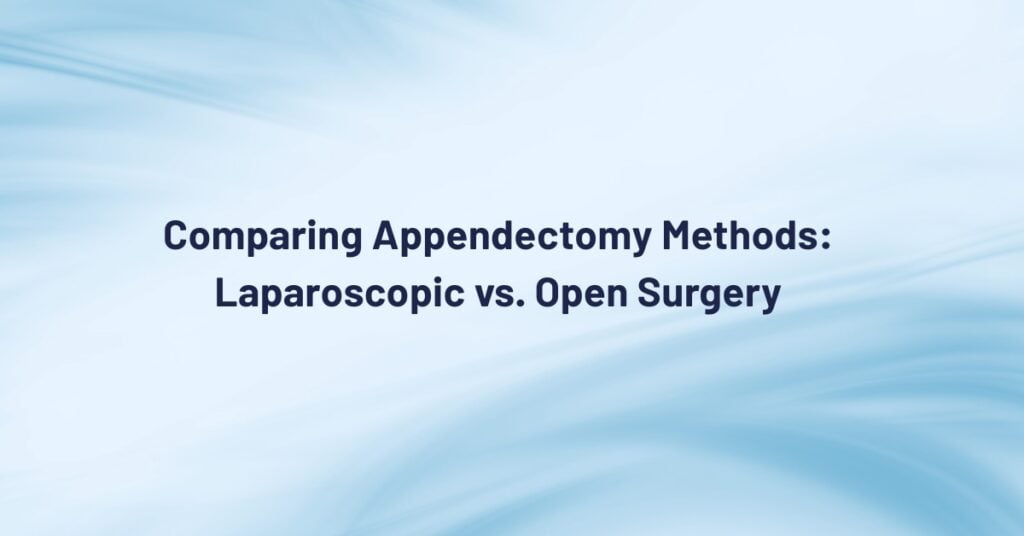When it comes to the surgical treatment of appendicitis, choosing the right method can have a significant impact on recovery, comfort, and overall outcomes. Patients and healthcare providers often weigh the differences between laparoscopic and open surgery to decide which approach best suits an individual’s needs—particularly when it comes to restoring health as quickly and safely as possible.
Understanding Appendicitis and Its Treatment
Appendicitis is a medical emergency involving inflammation of the appendix, a small pouch connected to the large intestine. If left untreated, the appendix can rupture and lead to complications such as infection and abscess formation. Consequently, an appendectomy—the surgical removal of the appendix—frequently becomes necessary.
There are two main methods for performing an appendectomy: laparoscopic and open surgery. Although both techniques address the same objective—removing the inflamed appendix—the differences can be striking in terms of incision size, recovery, and potential risks. Understanding these distinctions empowers patients, caregivers, and even referring physicians to make informed healthcare decisions.
Advantages of Laparoscopic Appendectomy
A laparoscopic appendectomy is performed using small, strategically placed incisions in the abdomen. Doctors insert thin instruments with a tiny camera—called a laparoscope—providing them with a clear, magnified view of the surgical site. This minimally invasive method offers several advantages:
• Reduced Postoperative Pain: Smaller incisions often translate to less discomfort after surgery. Many patients find that pain management is easier and that they resume regular activities sooner.
• Quicker Recovery: Due to the minimal disruption of abdominal tissues, patients typically experience shorter hospital stays and a faster return to normal routines.
• Lower Risk of Wound Infections: The smaller incisions reduce the likelihood of infection. Patients are less prone to complications such as surgical-site infections, which can sometimes extend the recovery period.
• Enhanced Cosmetic Results: Small abdominal incisions generally lead to less noticeable scarring, a factor that some individuals value when considering surgical options.
At Mountain View Surgical Associates in Colorado, surgeons often utilize laparoscopic and robotic-assisted approaches to perform appendectomies and other procedures. Their expertise in minimally invasive methods helps patients experience a smoother recovery, shorter downtime, and a quicker return to work or everyday activities.
Challenges of Open Appendectomy
Open appendectomy, on the other hand, is considered the traditional approach. Surgeons create a larger incision—usually on the lower right side of the abdomen—to directly visualize and remove the appendix. While this method has stood the test of time, it presents specific considerations:
• Longer Recovery Period: Because open appendectomy involves more extensive incisions, patients may require additional pain management and typically need a longer timeframe to heal.
• Feelings of Discomfort: Some individuals report greater levels of pain initially, as well as a higher likelihood of developing wound-related complications.
• Preference in Complex Cases: Despite the availability of laparoscopic techniques, certain situations call for open appendectomy. If an appendix has already ruptured or if there is a more complicated intra-abdominal condition, open surgery can provide increased visibility and access for the surgeon.
Comparing Recovery and Outcomes
Regardless of the chosen technique, both forms of appendectomy aim to resolve appendicitis safely and prevent complications. However, laparoscopic surgery is typically associated with:
• Less Postoperative Pain
• Faster Return to Normal Activities
• A Possible Reduction in Overall In-Hospital Time
From a long-term perspective, both laparoscopic and open surgeries produce similar outcomes in treating appendicitis, so neither method is universally superior. The key lies in matching the right surgical approach to the right patient.
Role of Surgeon Expertise
The expertise of the operating surgeon can significantly influence patient outcomes. Surgeons skilled in advanced, minimally invasive techniques often achieve high success rates with laparoscopic appendectomies, particularly in routine cases of appendicitis
Assessing Patient-Specific Factors
Factors such as age, medical history, the severity of inflammation, and other ailments play crucial roles in determining the most appropriate surgical approach. Communication between the patient and healthcare provider ensures that every relevant detail—like other abdominal surgeries or the presence of chronic diseases—is considered. By taking a personalized, collaborative approach, the surgical team can devise a strategy that optimizes recovery and comfort.
It’s also important to understand any insurance coverage or financial considerations ahead of time. The staff members at Mountain View Surgical Associates help guide patients through the process, from preoperative tests and approvals to postoperative care. This holistic support can alleviate stress and bring clarity to an often-complex situation.
Additional Resources
For anyone seeking deeper insights into the appendectomy process and the specifics of pre-surgery preparation, anesthesia, or tips for improving recovery, visit our comprehensive appendectomy information page. By gathering all the facts and having open discussions with a trusted healthcare professional, patients can feel more confident about the decisions that affect their well-being.
Mountain View Surgical Associates also hosts a range of procedures beyond appendectomies, including bariatric surgeries for weight loss, hernia repairs, gallbladder removals, colon resections, and other complex interventions. With a firm dedication to cutting-edge surgical techniques, the team remains committed to fostering better outcomes and supporting patients on their paths toward long-term health.


